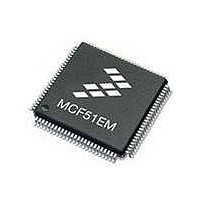MCF51EM256CLL Freescale Semiconductor, MCF51EM256CLL Datasheet - Page 618

MCF51EM256CLL
Manufacturer Part Number
MCF51EM256CLL
Description
IC MCU 32BIT 256KB FLASH 100LQFP
Manufacturer
Freescale Semiconductor
Series
MCF51EMr
Datasheets
1.MCF51EM128CLL.pdf
(2 pages)
2.MCF51EM128CLL.pdf
(54 pages)
3.MCF51EM128CLL.pdf
(636 pages)
Specifications of MCF51EM256CLL
Core Processor
Coldfire V1
Core Size
32-Bit
Speed
50MHz
Connectivity
I²C, SCI, SPI
Peripherals
LCD, LVD, PWM, WDT
Number Of I /o
63
Program Memory Size
256KB (256K x 8)
Program Memory Type
FLASH
Ram Size
16K x 8
Voltage - Supply (vcc/vdd)
1.8 V ~ 3.6 V
Data Converters
A/D 16x12b
Oscillator Type
External
Operating Temperature
-40°C ~ 85°C
Package / Case
100-LQFP
Processor Series
MCF51EM
Core
ColdFire V1
Data Bus Width
32 bit
Data Ram Size
16 KB
Interface Type
RS-232, LIN
Maximum Clock Frequency
50 MHz
Number Of Timers
3
Operating Supply Voltage
1.8 V to 3.6 V
Maximum Operating Temperature
+ 85 C
Mounting Style
SMD/SMT
3rd Party Development Tools
JLINK-CF-BDM26, EWCF
Development Tools By Supplier
DEMOEM
Minimum Operating Temperature
- 40 C
Lead Free Status / RoHS Status
Lead free / RoHS Compliant
Eeprom Size
-
Lead Free Status / Rohs Status
Lead free / RoHS Compliant
Available stocks
Company
Part Number
Manufacturer
Quantity
Price
Company:
Part Number:
MCF51EM256CLL
Manufacturer:
FREESCALE
Quantity:
110
Company:
Part Number:
MCF51EM256CLL
Manufacturer:
Freescale Semiconductor
Quantity:
10 000
- Current page: 618 of 636
- Download datasheet (11Mb)
Version 1 ColdFire Debug (CF1_DEBUG)
attempting to send any new command that requires CPU execution. This prevents the new command from
being discarded at the debug/CPU interface, due to the pending command being executed by the CPU. Any
new command should be issued only after XCSR[CSTAT] is cleared.
There are multiple reasons that could cause a command to take too long to execute, measured in terms of
the serial communication rate: The BDC clock frequency could be much faster than the CPU clock
frequency, or the CPU could be accessing a slow memory, which would cause pipeline stall cycles to occur.
All commands referencing the CPU registers or memory require access to the processor’s local bus to
complete. If the processor is executing a tight loop contained within a single aligned longword, the
processor may never successfully grant the internal bus to the debug command. For example:
label1: nop
or
label2: bra.w
These two examples of tight loops exhibit the BDM lockout behavior. If the loop spans across two
longwords, there are no issues, so the recommended construct is:
label3: bra.l
The hardware handshake protocol is appropriate for these situations, but the host could also decide to use
the software handshake protocol instead. In this case, if XCSR[CSTAT] is 001, there is a BDC command
pending at the debug/CPU interface. The host controller should monitor XCSR[CSTAT] and wait until it
is 000 to be able to issue a new command that requires CPU execution. However, if the XCSR[CSTAT] is
1xx, the host should assume the last command failed to execute. To recover from this condition, the
following sequence is suggested:
Figure 26-22
command could be issued by the host.
26-54
1. Issue a SYNC command to reset the BDC communication channel.
2. The host issues a BDM NOP command.
3. The host reads the channel status using a READ_XCSR_BYTE command.
4. If XCSR[CSTAT] is 000
then the status is okay; proceed
else
align
bra.b
align
align
shows a SYNC command aborting a READ_MEM.B. After the command is aborted, a new
Halt the CPU using a BDM BACKGROUND command
Repeat steps 1,2,3
If XCSR[CSTAT] is 000, then proceed, else reset the device
MCF51EM256 Series ColdFire Integrated Microcontroller Reference Manual, Rev. 8
4
label1
4
label2
4
label3
Figure 26-22
signal timing is not drawn to scale.
NOTE
Freescale Semiconductor
Related parts for MCF51EM256CLL
Image
Part Number
Description
Manufacturer
Datasheet
Request
R

Part Number:
Description:
BOARD DEMO HARDWARE ONLY
Manufacturer:
Freescale Semiconductor
Datasheet:

Part Number:
Description:
IC MCU 32BIT 128KB FLASH 100LQFP
Manufacturer:
Freescale Semiconductor
Datasheet:

Part Number:
Description:
IC MCU 32BIT 128KB FLASH 80LQFP
Manufacturer:
Freescale Semiconductor
Datasheet:

Part Number:
Description:
IC MCU 32BIT 256KB FLASH 80LQFP
Manufacturer:
Freescale Semiconductor
Datasheet:
Part Number:
Description:
Manufacturer:
Freescale Semiconductor, Inc
Datasheet:
Part Number:
Description:
Manufacturer:
Freescale Semiconductor, Inc
Datasheet:
Part Number:
Description:
Manufacturer:
Freescale Semiconductor, Inc
Datasheet:
Part Number:
Description:
Manufacturer:
Freescale Semiconductor, Inc
Datasheet:
Part Number:
Description:
Manufacturer:
Freescale Semiconductor, Inc
Datasheet:
Part Number:
Description:
Manufacturer:
Freescale Semiconductor, Inc
Datasheet:
Part Number:
Description:
Manufacturer:
Freescale Semiconductor, Inc
Datasheet:
Part Number:
Description:
Manufacturer:
Freescale Semiconductor, Inc
Datasheet:
Part Number:
Description:
Manufacturer:
Freescale Semiconductor, Inc
Datasheet:
Part Number:
Description:
Manufacturer:
Freescale Semiconductor, Inc
Datasheet:











